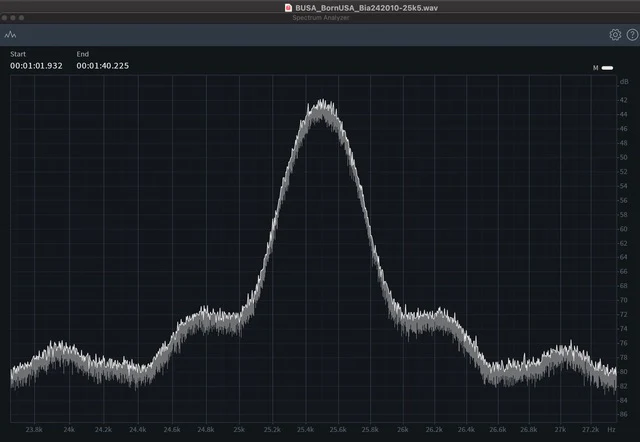Frank Doris's article is republished from PS Audio's Copper magazine, Issue 131, and was submitted by him as one of Frank's ongoing contributions to Positive Feedback.
As a hard-core audiophile, I've spent the better part of my life working on improving my audio systems. I'll admit—mostly because of selfishness. I want to hear music reproduced as perfectly as possible. I don't want merely good. I want incredible, mind-blowing.
I'm extremely happy with the way my system sounds now, but I know it could be better.
Will we ever have audio systems that literally sound like the real thing? The obvious answer is no. After all, as Galen Gareis (see his Copper articles in this issue and in Issue 130) has noted, you can't beat the laws of physics. But what if you could, or at least work around them? Why not dream of the day when music systems can sound exactly like live music?
This is going to involve some pie-in-the-sky speculation and I invite readers to tell me I'm completely crazy, or laugh uproariously at my lack of scientific knowledge. But, we all want perfect audio reproduction. (Except for looking at mics, I'm going to skip over the fact that the recording chain would also have to achieve perfection.) How can we get it? Not only don't I know the answers, I don't even know if I'm asking the right questions. I'm putting this out there as food for thought, and to encourage comments.
The deviation from sonic reality starts right at the beginning of the recording process. As soon as the sound of the vocalist, instrument or whatever acoustic waves that are traveling through the air hits the microphone, it's already game over. The microphone diaphragm has mass, and inertia. Objects at rest tend to stay at rest and objects in motion tend to stay in motion, whether a car or a microphone diaphragm. No matter how delicate the mic's diaphragm, it can't move in an exact reproduction of the sound hitting it.
The song doesn't remain the same: as soon as the sound hits the mic, even an excellent one like this Neumann, it loses something.
So how do you solve that? Eliminate the mass! Create a massless microphone. In fact, there have been attempts at this, including plasma microphones and laser beamforming, where laser-induced (air) breakdown (LIB) generates an audio signal. Here's a laser-and-smoke proof of concept microphone. This example doesn't sound good, but it's a prototype of a patented technology created years ago so who knows where it could lead?
At an AES convention once, I mentioned the idea of a massless microphone to the director of engineering of a well-known audio company. The person gave me a sharp look and replied, "we've actually got some ideas about that but if I told you, I'd have to kill you!"
The converse of the sound hitting the microphone is, of course, the sound coming out of the loudspeakers. Here the problem of overcoming mass and inertia is greater, since we're dealing with the movement of much larger speaker diaphragms and voice coil assemblies. A partial solution that's already been in use is the use of a servo control mechanism, where motional feedback from the driver is sent (from an accelerometer attached to the driver) back to the amplifier, which then corrects its output in an attempt to control the "overhang" of the driver. This typically would be used with woofers and subwoofers. However, I don't know if it's ever been tried with midrange drivers or tweeters. Anyone?
As another approach, maybe some kind of DSP that doesn't actually measure the motional feedback from the drivers, but "anticipates" the drivers' behavior might be worth looking into. Musical signals and driver behavior can be extremely complex, but maybe it's just an engineering problem.
If we can dream of a massless diaphragm, why not a massless speaker? Actual massless speakers have in fact been demonstrated – dig this YouTube video featuring The Audiophiliac, Steve Guttenberg, and designer Nelson Pass of Pass Laboratories talking about his Ion Cloud speaker.
Nelson Pass and his Ion Cloud speaker on the cover of Stereophile, Volume 6, No. 1, 1983.
Those of you lucky enough to have heard an Ionovac tweeter can attest to its almost spooky purity. But so far, such designs have proven impractical or impossible to implement on a mass-market scale; as examples, the Ion Cloud produced high levels of ozone, and the legendary Hill Plasmatronics speaker had to be fueled with helium.
Interesting work is being done with carbon nanotube speakers, but they simply have less mass, not none, and the sound quality isn't there. Yet. And at a CES a few years ago, someone demonstrated a system that involved beaming an audio signal on an ultrasonic carrier wave, or something like that, but I couldn't attend the demo and don't remember the company's name. As I understand it, the system still needed a transducer to send the signal. Can any readers help?
Maybe there's a way to manipulate air that no one's thought of yet.
A pair of DuKane Ionovac plasma tweeters. If you've heard these, you know.
Let's consider our music sources. In the case of analog, it involves dragging a rock (the stylus) through a plastic medium (the record), then sending a minuscule signal created by a cantilever and electromagnetic generator (the rest of the cartridge) to an equalization circuit (the phono preamp). I think it's safe to say that such a system is never going to attain perfection. Analog tape seems no less odd when you really think about it—running a thin ribbon of plastic, coated with magnetically-responsive particles, through an electromagnetic tape head for recording and playback. On the other hand, like a bumblebee flying, it never ceases to amaze me at how such Rube Goldbergian devices can sound so utterly fantastic.
I can't help but think: might there be an entirely new way to record and reproduce a perfect analog musical signal that doesn't involve imperfect analog playback hardware? Some kind of as-yet-un-invented optical technology, maybe? I know, I know, there would be transduction involved in the acoustic-to-optical-to-electrical signal, but a man can dream, can't he?
Then there's digital. I'm not an engineer and don't want to debate how much of a sample rate is really adequate (we can leave that for the comments), but the idea of chopping up the audio signal and reconstructing it just seems…weird to me. (I know, I know, and I'm not that much of a techno-rube, but…still.) I do find the sound of high-resolution audio to be satisfying and enjoyable. But is it the sonic perfection we're looking for?
How about an audio system's preamplifiers and amplifiers? Many of us are familiar with the concept of "straight wire with gain," where the ideal amplification circuit would simply amplify the signal and add no coloration of its own. How could we make it happen, especially when veteran circuit designers and hobbyists know that not only can parts quality make a difference, but even the physical layout of the components on a board (because of RF susceptibility and other issues) can have a sonic impact?
The first thought might be to make a circuit (for other audio components, as well as preamps and amps) as simple as possible. Seems intuitive—simple circuits might yield greater sonic purity. But then, every part in the sonic "recipe" of the circuit becomes more critical! And when you get into the real world, the simpler-is-better analogy simply falls apart. My second thought is, make the actual product smaller. Minimize the distance between the internal components. OK, maybe not—just try to make a conventional power amp with inadequate output transformers and see how it performs. Although, the remarkably small size of Class D amplification circuitry is a tantalizing glimpse of what can be done. And, have we really explored the limits of what integrated circuit or passive component miniaturization might sound like?
An ICEPower 1000A Class D mono amp module. It measures about 4 inches square and puts out 1000 watts.
Maybe digital signal processing (DSP) is the answer. In much the same manner that servo mechanisms can control the behavior of loudspeakers, and negative feedback can improve the sound in amplifiers, DSP can correct for all kinds of audio behavior, not the least of which is loudspeaker room-response correction. But perhaps other sonic areas could benefit in ways that no one's thought of yet.
Speaking of the room, we encounter another major issue. The room the recording was made in won't match the acoustics of your listening room—one will be overlaid on top of the other. How on Earth will that ever be overcome? Why do the initials "DSP" appear in my head yet again? It would be a daunting if not impossible task—how would we ever quantify the uncountable acoustic signatures of bazillions of recordings and figure out how to eliminate the acoustic effects of each person's listening room? Call me the Man of La Mancha.
Back to a straight wire with gain. Wouldn't cables literally be the closest manifestation of this? If only. Cables have resistance, capacitance and inductance as well as other variables like skin effect and (thank you again Galen) different velocity of propagation across the frequency band. Then there are the impedance mismatches between amplifier, cable and speaker, or between the electronics in the system (for example, the preamp and amplifier) to consider. How to eliminate all that? Are you thinking what I'm thinking? Wireless signal transmission. But then, you need to have transducers at the signal source and the playback device to convert the wireless signal back to an electrical one, and how much fidelity are you going to lose in the process? (And here you have an argument in favor of integrated amplifiers or all-in-one components that reduce the number of wired connections.) Still, the idea of a completely transparent wireless technology is intriguing.
Getting into the realm of science fiction, how about bypassing an audio system altogether with some kind of a direct neural implant? Cochlear implants are already a reality and research is ongoing, so who's to say an implanted high-end audio system couldn't be done someday? Of course, the first thing you'd have to listen to would be Steely Dan's Aja. (Dan fans will get the reference.) Even better—the implant could include a direct brain interface with a streaming service, so all you'd have to do is think of a song and it would play. You could adjust the sound just by thinking, and have a soundstage as vast as the Grand Canyon if you wanted.
Wired for sound: a cochlear implant. Courtesy of Wikimedia Commons/Blausen.com staff.
I've spent all this time considering the hardware. What about us, the actual people who are going to be listening to all this stuff? Could there be some way to put us into a state of mind or affect us in a way that makes our audio systems seem more "real"? I know what you're thinking…but I don't know if psychoactive drugs are gonna get you there. But seriously, could a drug be developed that gives us better hearing acuity? Or some kind of audio-enhancement hearing aid that lets us hear our systems with better fidelity?
One last thought. Many industry giants have worked to advance the field of high fidelity. Perhaps some great ideas have been lost, and are waiting to be rediscovered.
As Walt Disney once didn't say, if you can dream it, you can do it.
Header image courtesy of Pixabay/Gerd Altmann.












































